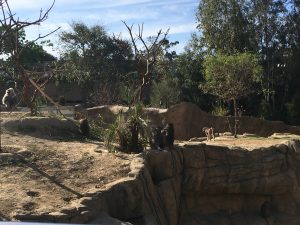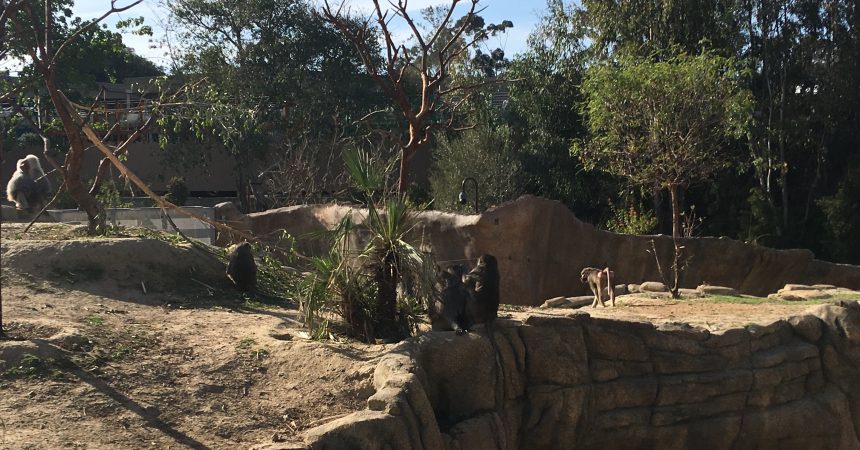Zoo InternQuest is a seven-week career exploration program for San Diego County high school juniors and seniors. Students have the unique opportunity to meet professionals working for the San Diego Zoo, Safari Park, and Institute for Conservation Research, learn about their jobs and then blog about their experience online. Follow their adventures here on the Zoo’s website!

The baboons can often be found grooming each other, hanging out on their rocky perches, and taking group laps around the exhibit. Be sure to pay them a visit the next time you’re at the Zoo!
Roughly five years ago, a meeting was held at the San Diego Zoo to inform primate keepers of the Zoo’s next big project- the sprawling exhibit we now know as Africa Rocks. As the discussion progressed, the keepers were told that some of the future residents of Africa Rocks would include a group of baboons. These weren’t just any baboons, either – there were nineteen of them in all, and they would be coming to the Zoo from Germany with minimal training. What’s more, at least one of the meeting’s attendees would have to step up and take on the job of baboon keeper. The room fell silent. All keeper jobs are challenging, but this task seemed especially formidable. Not only would the keeper in charge have to work with a large group of baboons with very little previous training experience, he or she would also have to help orchestrate a cross-continental move for the animals! The very idea was daunting. As the keepers in the room sat in uncomfortable silence, though, one man began to see that the challenges presented by the job would also be what made it exciting. His hand shot up to volunteer, and the rest is history.
Though stepping into the role of baboon keeper was going to be difficult, to say the least, Dustin Black was the man for the job. From a young age, Black knew that he had a unique gift for working with animals. He raised injured baby birds (and even an abandoned baby possum!) and often visited the Zoo, SeaWorld, and the Safari Park with his mother and grandmother. A young Mr. Black knew that he wanted a future that let him work with the animals he loved, but he wasn’t quite sure what that future looked like. That all changed, though, thanks to a fortuitous visit to the career counselor. On the day in question, Mr. Black was called into his middle school’s career counselor and asked, essentially, what he wanted to do with his life. When Mr. Black began to talk about his love for animals and desire to work in the zoological field, the counselor swiveled the picture on his desk to show Mr. Black his son. As the counselor told Mr. Black, his son had once had aspirations just like Mr. Black’s and was now working his dream job as a trainer at SeaWorld. Before earning this position, the counselor’s son had studied at Moorpark College, the only college to offer a degree in exotic animal training. Mr. Black was entranced. When he arrived home that day, he marched right up to his mother and told her that he would one day attend Moorpark College – and that’s exactly what he did.
Though some college graduates may struggle to find employment right away, Mr. Black graduated from Moorpark College with his first animal keeper job already lined up. He worked as an elephant trainer at Marineland in Northern California for two years, gaining valuable experience and skills, and then moved down to San Diego to put his elephant know-how to work at the Zoo. When Mr. Black worked with the elephants in the 1990s, it was free contact work, meaning that the keepers were able to be in the exhibit with the elephants and carry out daily routines with the animals without a physical barrier between them. Although danger was always present when working free contact, Mr. Black liked this aspect of his job because of the trust it helped him create between himself and the elephants. When the Zoo switched to protected contact in 1998, Mr. Black decided that he was ready for a new challenge. Shortly after, he became a hoofstock keeper and worked in this position for some time before being asked to become a primate keeper. Primates are highly intelligent animals who require a great amount of care and enrichment opportunities, and Mr. Black says that it took him a while to really feel comfortable and confident as a primate keeper. However, when the opportunity to work with the troop of baboons presented itself, Mr. Black’s can-do attitude, ability to adapt, and long history with animal keeping made him a great fit.
As you can probably guess, life as a baboon keeper is anything but mundane. Mr. Black spends his days planning new enrichment for the baboons, organizing and preparing nutritious meals, interacting with visitors, and yes, cleaning out the baboon’s exhibit. One of the greatest challenges, though was figuring out how to introduce these German-born primates to life at the San Diego Zoo. A move of this kind had never been attempted before with such a large group of baboons, and Mr. Black and his colleagues really had to take it one step at a time and give the animals plenty of time to acclimate. Thankfully, though, Mr. Black soon found that food was a great motivator for his new charges – true to the cliche, his monkeys were more than willing to work in return for a nice banana. After just over a year at the Zoo, the baboons have flourished under Mr. Black’s care and are living happily in their large exhibit in Africa Rocks. For Mr. Black, this success story marks just another milestone in his 25-year career as an animal keeper. As for what the future holds, Mr. Black is certain that he wants to remain a keeper and work with animals for as long as possible. After all, why would you ever want to change careers when you’re self-proclaimed as “one of the most interesting keepers at the Zoo”?
Allison, Careers Team
Week Three , Spring Session 2018


